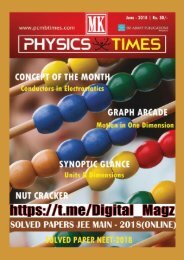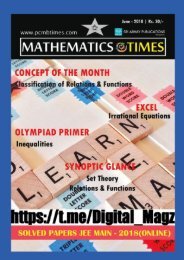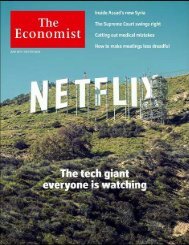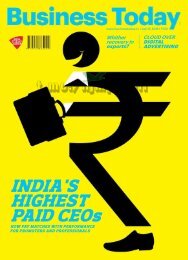Fortune
You also want an ePaper? Increase the reach of your titles
YUMPU automatically turns print PDFs into web optimized ePapers that Google loves.
FOREWORD<br />
SPRINGTIME<br />
FORA.I.<br />
ON FEB. 24, 1956, ARTHUR LEE SAMUEL played a game of checkers on<br />
television. His opponent: a 36-bit vacuum tube computer made by<br />
International Business Machines.<br />
Samuel, then a 55-year-old researcher at IBM, had painstakingly<br />
assigned each of the 64 squares on the checkerboard a diferent set of<br />
machine-word identifiers, and done the same with each piece on each<br />
square. Then he programmed his IBM 701 computer to think: that is, to<br />
consider a few possible checkers moves “by evaluating the resulting board<br />
positions much as a human player might do,” Samuel would later write.<br />
“ ‘Looking ahead’ is prepared for by computing all possible next moves,<br />
starting with a given board position,” he explained. For each of those<br />
potential moves, the computer would redraw the board in its electronic<br />
brain with “the old board positions being saved to facilitate a return<br />
to the starting point,” and then the process would repeat. When the<br />
indicated move didn’t result in a better outcome, the IBM 701 would try<br />
another one, and so forth, until the machine was successful.<br />
In short, Samuel had programmed the “digital computer to behave in<br />
a way which, if done by human beings or animals, would be described as<br />
involving the process of learning,” he said.<br />
Before the televised match, IBM president Tom Watson—the namesake<br />
of IBM’s current-model thinking machine—predicted his company’s<br />
shares would soar after the demonstration. They did just that.<br />
What followed was a heady period of excitement during the 1950s and<br />
1960s, when computer scientists sketched out dreams and designs of<br />
advanced problem-solving machines that, in many cases, mirrored the<br />
robotic creations of science fiction novels.<br />
What followed that, however, was a long reality check—a period that,<br />
it turns out, was far less “cyborg” than incremental science. Over the next<br />
half-century, many of the most ambitious fantasies of artificial intelligence<br />
were often met with prosaic, real-world limitations. The progress<br />
was genuine, of course—from mathematical breakthroughs to major<br />
advances in computing power. But still the perceived failures led to long<br />
fallow periods that many in the field dubbed “A.I. winters.”<br />
Well, it’s spring again in the realm of A.I.—and the ambition (and<br />
hype) are blooming big-time. Big companies are now feverishly gobbling<br />
up startups—firms that are teaching machines to master the idiosyncrasies<br />
of human conversation, to expertly recognize the world around<br />
them, and to instantly scan terabytes of data to discover patterns that no<br />
mere mortal could recognize.<br />
www.t.me/velarch_official<br />
Yes, a lot has changed, as<br />
we explore in our A.I. Special<br />
Report this issue (see the package<br />
of articles that begins on<br />
page 54). But as writers Jonathan<br />
Vanian and Vauhini Vara<br />
show, it’s time for another reality<br />
check. As the capacity of these<br />
algorithms grows exponentially,<br />
so do the questions about their<br />
potential biases and their risky<br />
assumptions. It’s an ongoing<br />
lesson that requires our own<br />
attempt at deep learning. The<br />
success of this latest stage of A.I.<br />
development may depend on it.<br />
Which brings me to our cover<br />
story. As “thoughtful” as some<br />
machines are becoming, there<br />
are none (yet) that can mimic<br />
the spark of creative energy at<br />
the heart of entrepreneurship.<br />
Creating a company and building<br />
it may be one of the most<br />
human things that humans do.<br />
Which is one of many reasons<br />
I find Adam Lashinsky’s feature<br />
story on Jack Ma and Huateng<br />
“Pony” Ma—the mightily ambitious<br />
founders, respectively,<br />
of Alibaba and Tencent—such<br />
an intoxicating read. In “Ma<br />
vs. Ma” (see page 72), Adam<br />
expertly depicts what may be the<br />
biggest corporate battle in China<br />
while taking us inside an Internet<br />
ecosystem that may spread<br />
rapidly around the world.<br />
For a grand tour of intelligence,<br />
both artificial and real,<br />
read on. And please, as always,<br />
let us know what you think.<br />
CLIFTON LEAF<br />
Editor-in-Chief,<strong>Fortune</strong><br />
@CliftonLeaf<br />
8<br />
FORTUNE.COM // JULY.1.18
















